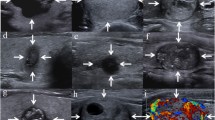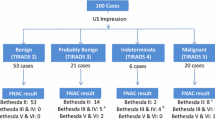Abstract
Objective
To assess performance of TIRADS classification on a prospective surgical cohort, demonstrating its clinical usefulness.
Methods
Between June 2009 and October 2012, patients assessed with pre-operative ultrasound (US) were included in this IRB-approved study. Nodules were categorised according to our previously described TIRADS classification. Final pathological diagnosis was obtained from the thyroidectomy specimen. Sensitivity, specificity, positive/negative predictive values and likelihood ratios were calculated.
Results
The study included 210 patients with 502 nodules (average: 2.39 (±1.64) nodules/patient). Median size was 7 mm (3–60 mm). Malignancy was 0 % (0/116) in TIRADS 2, 1.79 % (1/56) in TIRADS 3, 76.13 % (185/243) in TIRADS 4 [subgroups: TIRADS 4A 5.88 % (1/17), TIRADS 4B 62.82 % (49/78), TIRADS 4C 91.22 % (135/148)], and 98.85 % (86/87) in TIRADS 5. With a cut-off point at TIRADS 4–5 to perform FNAB, we obtained: sensitivity 99.6 % (95 % CI: 98.9–100.0), specificity 74.35 % (95 % CI: 68.7–80.0), PPV 82.1 % (95 % CI: 78.0–86.3), NPV 99.4 % (95 % CI: 98.3–100.0), PLR 3.9 (95 % CI: 3.6–4.2) and an NLR 0.005 (95 % CI: 0.003–0.04) for malignancy.
Conclusion
US-based TIRADS classification allows selection of nodules requiring FNAB and recognition of those with a low malignancy risk.
Key Points
• TIRADS classification allows accurate selection of thyroid nodules requiring biopsy (TIRADS 4–5).
• The recognition of benign/possibly benign patterns can avoid unnecessary procedures.
• This classification and its sonographic patterns are validated using surgical specimens.




Similar content being viewed by others
Abbreviations
- US:
-
Ultrasound
- FNAB:
-
Fine needle aspiration biopsy
- PPV:
-
Positive predictive value
- NPV:
-
Negative predictive value
- PLR:
-
Positive likelihood ratio
- NLR:
-
Negative likelihood ratio
References
Gharib H, Papini E, Paschke R, Duick DS, Valcavi R, Hegedüs L, et al. American Association of Clinical Endocrinologists, Associazione Medici Endocrinologi, and European Thyroid Association Medical Guidelines for Clinical Practice for the Diagnosis and Management of Thyroid Nodules (2010). Endocr Pract 16:1–43
Sipos J (2009) Advances in ultrasound for the diagnosis and management of thyroid cancer. Thyroid 19:1363–1372
Horvath E, Majlis S, Rossi R, Franco C, Niedmann JP, Castro A et al (2009) An ultrasonogram reporting system for thyroid nodules stratifying cancer risk. J Clin Endocrinol Metab 94:1748–1751
American College of Radiology (ACR) (2003) ACR BI-RADS® - Ultrasound. In: ACR Breast Imaging Reporting and Data System, Breast Imaging Atlas. Reston, VA. American College of Radiology
Domínguez M, Franco C, Contreras L, Torres J, Volpato R, Cerpa F et al (1995) Fine needle aspiration biopsy of thyroid nodules. Analysis of results obtained using a new method with histological examination of the sample. [Article in Spanish]. Rev Med Chil 123:982–990
Cibas ES, Ali SZ (2009) The Bethesda system for reporting thyroid cytopathology. Thyroid 19:1159–1165
Guth S, Theune U, Aberle J, Galach A, Bamberger CM (2009) Very high prevalence of thyroid nodules detected by high frequency (13 MHz) ultrasound examination. Eur J Clin Investig 39:699–706
Koike E, Noguchi S, Yamashita H et al (2001) Ultrasonographic characteristics of thyroid nodules: prediction of malignancy. Arch Surg 136:334–337
Kim EK, Park CS, Chung WY, Oh KK, Kim DI, Lee JT et al (2002) New sonographic criteria for recommending fine-needle aspiration biopsy of nonpalpable solid nodules of the thyroid. AJR Am J Roentgenol 178:687–691
Papini E, Guglielmi R, Bianchini A, Crescenzi A, Taccogna S, Nardi F et al (2002) Risk of malignancy in nonpalpable thyroid nodules: predictive value of ultrasound and color-Doppler features. J Clin Endocrinol Metab 87:1941–1946
Cappelli C, Castellano M, Pirola I, Cumetti D, Agosti B, Gandossi E et al (2007) The predictive value of ultrasound findings in the management of thyroid nodules. QJM 100:29–35
Tae HJ, Lim DJ, Baek KH, Park WC, Lee YS, Choi JE et al (2007) Diagnostic value of ultrasonography to distinguish between benign and malignant lesions in the management of thyroid nodules. Thyroid 17:461–466
Ito Y, Amino N, Yokozawa T, Ota H, Oshita M, Murata N et al (2007) Ultrasonographic evaluation of thyroid nodules in 900 patients : comparison among ultrasonographic, cytological and histological findings. Thyroid 17:1269–1276
Ito Y, Amino N, Miyauchi A (2010) Thyroid ultrasonography. World J Surg 34:1171–1180
Park JY, Lee HJ, Jang HW, Kim HK, Yi JH, Lee W et al (2009) A proposal for a thyroid imaging reporting and data system for ultrasound features of thyroid carcinoma. Thyroid 19:1257–1264
Russ G, Bigorgne C, Royer B, Rouxel A, Bienvenu-Perrard M (2011) The Thyroid Imaging Reporting and Data System (TIRADS) for ultrasound of the thyroid. [Article in French]. J Radiol 92:701–713
Kwak JY, Han KH, Yoon JH, Moon HJ, Son EJ, Park SH et al (2011) Thyroid imaging reporting and data system for US features of nodules: a step in establishing better stratification of cancer risk. Radiology 260:892–899
Russ G, Royer B, Bigorgne C, Rouxel A, Bienvenu-Perrard M, Leenhardt L (2013) Prospective evaluation of thyroid imaging reporting and data system on 4550 nodules with and without elastography. Eur J Endocrinol 168:649–655
Zayadeen AR, Abu-Yousef M, Berbaum K (2016) Retrospective evaluation of ultrasound features of thyroid nodules to assess malignancy risk: a step toward TIRADS. AJR 207:1–10
Seo H, Na DG, Kim JH, Kim KW, Yoon JW (2015) Ultrasound-based risk stratification for malignancy in thyroid nodules: a four-tier categorization system. Eur Radiol 25(7):2153–2216
Wémeau JL, Sadoul JL, d'Herbomez M, Monpeyssen H, Tramalloni J, Leteurtre E, et al (2011) Guidelines of the french society of endocrinology for the management of thyroid nodules. Ann Endocrinol (Paris) 72(4):251–81
Frates MC, Benson CB, Charboneau JW, Cibas ES, Clark OH, Coleman BG, et al (2005) Management of thyroid nodules detected at US: society of radiologists in ultrasound consensus conference statement. Radiology 237:794–800
American Thyroid Association (ATA) Guidelines Taskforce on Thyroid Nodules and Differentiated Thyroid Cancer, Cooper DS, Doherty GM, Haugen BR, Kloos RT, Lee SL, et al (2009) Revised American Thyroid Association management guidelines for patients with thyroid nodules and differentiated thyroid cancer. Thyroid 19:1167–1214
Haugen BR, Alexander EK, Bible KC, Doherty GM, Mandel SJ, Nikiforov YE, et al (2015) American thyroid association management guidelines for adult patients with thyroid nodules and differentiated thyroid cancer: the American thyroid association guidelines task force on thyroid nodules and differentiated thyroid cancer. Thyroid 26:1–133
Cantisani V, Maceroni P, D'Andrea V, Patrizi G, Di Segni M, De Vito C, et al (2016) Strain ratio ultrasound elastography increases the accuracy of colour-Doppler ultrasound in the evaluation of Thy-3 nodules. A bi-centre university experience. Eur Radiol 26(5):1441–1449
Giusti M, Orlandi D, Melle G, Massa B, Silvestri E, Minuto F, et al (2013) Is there a real diagnostic impact of elastosonography and contrast-enhanced ultrasonography in the management of thyroid nodules? J Zhejiang Univ Sci B 14(3):195–206
Ma X, Zhang B, Ling W, Liu R, Jia H, Zhu F, et al (2016) Contrast-enhanced sonography for the identification of benign and malignant thyroid nodules: systematic review and meta-analysis. J Clin Ultrasound 44(4):199–209
Acknowledgments
The scientific guarantor of this publication is Eleonora Horvath MD. The authors of this manuscript declare no relationships with any companies whose products or services may be related to the subject matter of the article. The authors state that this work has not received any funding. No complex statistical methods were necessary for this paper. Institutional review board approval was obtained. Written informed consent was waived by the Institutional Review Board.
Methodology: retrospective, diagnostic or prognostic study performed at one institution.
Author information
Authors and Affiliations
Corresponding author
Electronic supplementary material
Below is the link to the electronic supplementary material.
ESM 1
(DOCX 212 kb)
Rights and permissions
About this article
Cite this article
Horvath, E., Silva, C.F., Majlis, S. et al. Prospective validation of the ultrasound based TIRADS (Thyroid Imaging Reporting And Data System) classification: results in surgically resected thyroid nodules. Eur Radiol 27, 2619–2628 (2017). https://doi.org/10.1007/s00330-016-4605-y
Received:
Revised:
Accepted:
Published:
Issue Date:
DOI: https://doi.org/10.1007/s00330-016-4605-y




